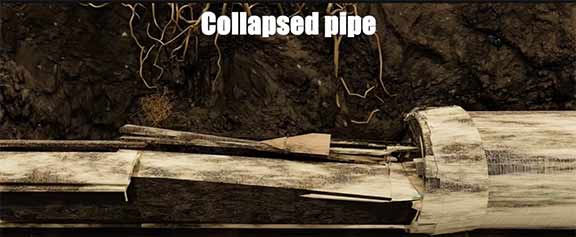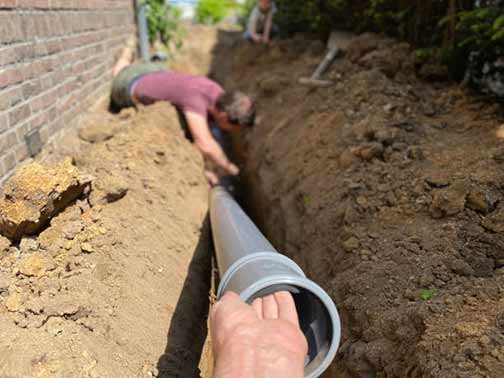
In the intricate world of plumbing and infrastructure, sewer lines are the unsung heroes that ensure sanitation and functionality for both residential and commercial properties. However, when these essential lines collapse, they can cause severe disruptions, lead to costly repairs, and pose significant health risks.
Below we provide a detailed exploration of collapsed sewer lines, getting into their causes, identifying warning signs, and examining effective solutions. Designed to cater to both homeowners and industry professionals, this guide aims to offer an in-depth understanding of this critical issue, empowering readers with the knowledge to address and prevent sewer line collapses.
Understanding the Causes of Sewer Line Collapse: From Natural Wear to Human Error
Sewer line collapses can happen due to a multitude of reasons, each contributing to the weakening and eventual failure of the pipe structure. Understanding these causes is crucial for both preventing future collapses and implementing effective remediation strategies.
Natural Wear and Tear: Over the years, sewer lines endure natural wear and tear. Older sewer systems, often constructed from materials like clay or cast iron, are particularly susceptible to degradation. Continuous exposure to moisture and the chemicals present in wastewater can weaken these materials, leading to eventual collapse.
Tree Root Infiltration: One of the most prevalent causes of sewer line collapse is the infiltration of tree roots. Trees, in their quest for moisture, can extend their roots into sewer pipes, causing blockages and structural damage.
Ground Shifting: Changes in the ground, such as soil erosion, seismic activity, or even construction work, can lead to the misalignment or collapse of sewer lines. This is especially common in areas with unstable soil conditions.
Improper Installation: Sewer lines that are improperly installed or constructed using substandard materials are more prone to collapse. Ensuring that installations are carried out by certified professionals can significantly mitigate this risk.
Recognizing the Warning Signs of a Collapsed Sewer Line: Early Detection is Key
Identifying the early warning signs of a collapsed sewer line can prevent extensive damage and costly repairs. Both homeowners and professionals should be vigilant for these indicators:
Persistent Clogs: Frequent clogs in multiple drains throughout the property may indicate a larger issue within the sewer line itself. This is often a sign of a blockage or structural failure.
Unpleasant Odors: The presence of foul odors emanating from drains or around the property can suggest a breach in the sewer system, allowing sewage to escape into the surrounding environment.
Slow Drainage: If water drains slowly from sinks, bathtubs, or toilets, it may signal a blockage or collapse in the sewer line. This is often one of the earliest signs of a problem.
Water Damage: Unexplained water pooling or moisture in the basement or around the foundation can be a sign of a compromised sewer line. This can lead to more serious structural issues if not addressed promptly.

Exploring Effective Solutions for Collapsed Sewer Lines: From Traditional to Innovative
Addressing a collapsed sewer line requires a strategic approach that combines modern technology with traditional repair methods. Here are some effective solutions:
Pipe Relining: This innovative technique involves inserting a resin-coated liner into the damaged pipe. Once cured, it forms a new, durable pipe within the old one, restoring functionality without the need for extensive excavation.
Pipe Bursting: In cases where the existing pipe is beyond repair, pipe bursting is a viable option. This method involves breaking the old pipe while simultaneously pulling a new pipe into place, ensuring a seamless replacement.
Excavation and Replacement: For severely damaged sewer lines, traditional excavation and a full replacement of the sewer lines may be necessary. While more invasive, this method ensures the complete removal of the compromised section, providing a fresh start.
Regular Maintenance: Routine inspections and maintenance can prevent sewer line collapses. Utilizing video inspections and hydro jetting can help identify and address potential issues before they escalate, saving time and money in the long run.
The Role of Technology in Sewer Line Maintenance: Enhancing Efficiency and Effectiveness
Advancements in technology have revolutionized the way sewer lines are maintained and repaired. From high-definition video inspections to trenchless repair methods, technology plays a crucial role in enhancing the efficiency and effectiveness of sewer line management.
Video inspections allow professionals to accurately diagnose the condition of sewer lines without invasive measures. This not only saves time but also reduces the cost of repairs by pinpointing the exact location and nature of the problem.
Trenchless technologies, such as pipe relining and bursting, minimize disruption to the property and surrounding infrastructure. These methods are not only cost-effective but also environmentally friendly, as they reduce the need for extensive excavation.
Implementing Preventive Measures for Homeowners: Safeguarding Your Sewer Systems
Homeowners can take several preventive measures to minimize the risk of sewer line collapse. Regular maintenance and awareness of potential hazards are key components in safeguarding the integrity of sewer systems.
Tree Management: Plant trees away from sewer lines and regularly inspect the growth of roots to prevent infiltration. This simple step can prevent significant damage and costly repairs.
Proper Waste Disposal: Avoid disposing of grease, oils, or non-biodegradable materials down the drain, as these can contribute to blockages and eventual sewer line collapse.
Routine Inspections: Schedule regular inspections with a professional plumber to assess the condition of your sewer lines and address any emerging issues promptly. Early detection can save significant time and money.
Conclusion: Ensuring the Longevity of Sewer Systems Through Knowledge and Action
Understanding the causes, warning signs, and solutions for collapsed sewer lines is essential for homeowners and industry professionals alike. By adopting preventive measures and utilizing modern technology, the longevity and functionality of sewer systems can be preserved.
This guide serves as a valuable resource for anyone seeking to maintain the integrity of their sewer infrastructure, ensuring a safe and sanitary environment for all. Through knowledge and proactive action, we can safeguard our communities from the challenges posed by collapsed sewer lines.

